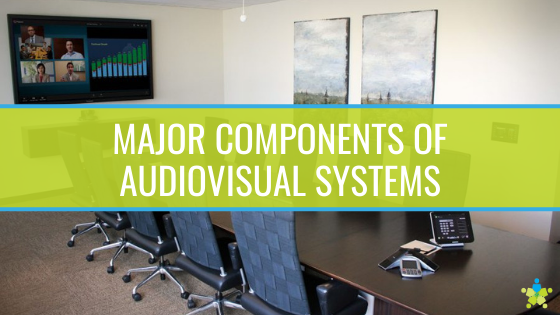- Audio and video conferencing solutions
- Digital displays and signage
- Video walls
- Interactive displays
- Audio enhancement technology
- Control systems
What do corporate AV solutions consist of?
AV solutions make it easier for companies to unify and standardize their communications throughout the organization, so team members can be reached wherever they are, quickly and easily. Conferencing solutions are effective at promoting this approach, and they include:• Cameras and displays – In a video conferencing system, a camera captures video from one endpoint and distributes it to other endpoints connected to the conference. There may only be a pair of endpoints involved, or there may be hundreds. For example, an executive may use a conference room to deliver an announcement to many other rooms, displays or devices.
• Microphones and speakers – The audio side of a video conference is captured by microphones and delivered to speakers at the other end. Microphones can be mounted to a surface, built into a surface, mounted inside the ceiling or suspended from the ceiling. The right choice comes down to appearance, footprint and audio clarity. For example, gooseneck microphones deliver excellent audio quality, but they take up more space than other microphones.
Speakers may be integrated with the display, which is typically sufficient for a smaller space like a huddle room. In medium to larger conference spaces, a set of speakers positioned for even sound distribution ensures everyone can hear.
• The codec – The codec is responsible for encoding and decoding the audio and visual data sent to each conferencing system and endpoint. Codecs are available in hardware and software forms, each with their own advantages. Hard codecs are ideal when call stability and quality is an absolute must, while soft codecs are less expensive and fast to implement.
In addition to conferencing solutions, digital signage solutions are a popular choice among businesses. They consist of the following technologies:• The display – Digital signage displays look like televisions, but they are designed for long term, continuous use. As such, they are built with more durable components, onboard fans and larger heat sinks to prevent thermal damage. Digital signage displays are available in an array of sizes and forms, as they can perform several roles. A restaurant may use digital signage to display menus. A luxury clothing store may use a large video wall to show off new arrivals. Businesses on a commercial plaza can use rugged exterior signage to catch the attention of people strolling by. Digital displays can be installed just about anywhere.
• The media player – The media player is what stores and sends signage layouts to the display. It’s essentially a small computer that makes signage functionality easy to manage.
• The signage software – Digital signage software allows users to create and edit layouts, program signage campaigns and perform other functions. If the signage can also be used as an instant messaging or emergency alert system, these can also be accessed through the signage software.
Applications can be used to add functionality to the signage system. Weather, news, sports scores and social media applications are just a few examples.
What AV technologies are useful for the classroom?
Schools can also make use of conferencing technology, though usually not in the classroom. Video conferencing, though, can be a compelling educational enhancement because it can connect students to experts from around the world. There are additional AV solutions designed for the classroom, including:• Interactive flat panels – Interactive flat panels are also useful in corporate settings, but its impact in education is immense. Interactive displays like the Clevertouch and ActivPanel are compelling classroom tools because they make it easy to present media-rich, engaging lessons. With an interactive flat panel, teachers can quickly build lessons using media from the internet or on the display’s onboard hard drive. Teachers can create notes during whiteboarding sessions, use quizzes and learning games to engage students, perform science experiments, graph equations, share content with students (and vice versa) and quickly assess student progress with rapid response questions.
Interactive flat panels are built for the classroom environment with safety glass and security features that allow IT to manage the displays remotely.
• VR and AR technology – Virtual reality (VR) and augmented reality (AR) are emerging frontiers in education, and several VR and AR systems, like ClassVR, are already available to educators. VR and AR are capable of producing novel learning experiences that would be impossible with anything else. For example, VR can simulate a moon landing experience, walking among the dinosaurs, an excursion into the pyramids or hundreds of other lessons that only work in VR.
AR uses a held or worn display to present virtual objects in a physical space. It’s easy to use and synergizes well with what students already know about technology. That means it integrates well into most schools.
Audiovisual systems are space-changers in the office and in the classroom. They make communication faster and more interesting and lessons more engaging and memorable. AV solutions are worth considering for every organization, especially if you have an experienced AV integrator handling the system design and implementation.


